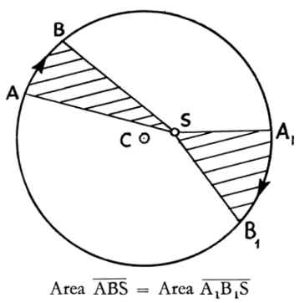The Sleepwalkers (156 page)
Authors: Arthur Koestler


Yet
the
last
step
which
had
got
him
out
of
the
labyrinth
had
once
again
been
a
faulty
step.
For
it
is
not
permissible
to
equate
an
area
with
the
sum
of
an
infinite
number
of
neighbouring
lines,
as
Kepler
did.
Moreover,
he
knew
this
well,
and
explained
at
length
why
it
was
not
permissible.
21
He
added
that
he
had
also
committed
a
second
error,
by
assuming
the
orbit
to
be
circular.
And
he
concluded:
"But
these
two
errors
–
it
is
like
a
miracle
–
cancel
out
in
the
most
precise
manner,
as
I
shall
prove
further
down."
22
The
correct
result
is
even
more
miraculous
than
Kepler
realized,
for
his
explanation
of
the
reasons
why
his
errors
cancel
out
was
once
again
mistaken,
and
he
got,
in
fact,
so
hopelessly
confused
that
the
argument
is
practically
impossible
to
follow,
as
he
himself
admitted.
And
yet,
by
three
incorrect
steps
and
their
even
more
incorrect
defence,
Kepler
stumbled
on
the
correct
law.
23
It
is
perhaps
the
most
amazing
sleepwalking
performance
in
the
history
of
science
–
except
for
the
manner
in
which
he
found
his
First
Law,
to
which
we
now
turn.
7.
The First Law
The
Second
Law
determined
the
variations
of
the
planet's
speed
along
its
orbit,
but
it
did
not
determine
the
shape
of
the
orbit
itself.
At
the
end
of
the
Second
Book,
Kepler
had
acknowledged
defeat
in
his
attempts
to
define
the
Martian
orbit
–
a
defeat
caused
by
a
discrepancy
of
eight
minutes
arc.
He
had
then
embarked
on
an
enormous
detour,
starting
with
the
revision
of
the
earth's
motion,
followed
by
physical
speculations,
and
terminating
in
the
discovery
of
the
Second
Law.
In
the
Fourth
Book
he
resumed
his
investigation
of
the
Martian
orbit
where
he
had
left
off.
By
this
time,
four
years
after
his
first,
frustrated
attempts,
he
had
become
even
more
sceptical
of
orthodox
dogma,
and
gained
an
unparalleled
skill
in
geometry
by
the
invention
of
methods
all
his
own.
The
final
assault
took
nearly
two
years;
it
occupies
chapters
41
to
60
of
the
New
Astronomy
.
In
the
first
four
(41-44),
Kepler
tried
for
the
last
time,
with
savage
thoroughness,
to
attribute
a
circular
orbit
to
Mars
and
failed:
this
section
ends
with
the
words:
"The
conclusion
is
quite
simply
that
the
planet's
path
is
not
a
circle
–
it
curves
inward
on
both
sides
and
outward
again
at
opposite
ends.
Such
a
curve
is
called
an
oval.
The
orbit
is
not
a
circle,
but
an
oval
figure."
But
now
a
dreadful
thing
happened,
and
the
next
six
chapters
(45-50)
are
a
nightmare
journey
through
another
labyrinth.
This
oval
orbit
is
a
wild,
frightening
new
departure
for
him.
To
be
fed
up
with
cycles
and
epicycles,
to
mock
the
slavish
imitators
of
Aristotle
is
one
thing;
to
assign
an
entirely
new,
lopsided,
implausible
path
for
the
heavenly
bodies
is
quite
another.
Why
indeed
an
oval?
There
is
something
in
the
perfect
symmetry
of
spheres
and
circles
which
has
a
deep,
reassuring
appeal
to
the
unconscious
–
otherwise
it
could
not
have
survived
two
millennia.
The
oval
lacks
all
such
archetypal
appeal.
It
has
an
arbitrary
form.
It
distorts
that
eternal
dream
of
the
harmony
of
the
spheres,
which
lay
at
the
origin
of
the
whole
quest.
Who
art
thou,
Johann
Kepler,
to
destroy
divine
symmetry?
All
he
has
to
say
in
his
own
defence
is,
that
having
cleared
the
stable
of
astronomy
of
cycles
and
spirals,
he
left
behind
him
"only
a
single
cartful
of
dung":
his
oval.
24
At
this
point,
the
sleepwalker's
intuition
failed
him,
he
seems
to
be
overcome
by
dizziness,
and
clutches
at
the
first
prop
that
he
can
find.
He
must
find
a
physical
cause,
a
cosmic
raison
d'être
for
his
oval
in
the
sky
–
and
he
falls
back
on
the
old
quack
remedy
which
he
has
just
abjured,
the
conjuring
up
of
an
epicycle!
To
be
sure,
it
is
an
epicycle
with
a
difference:
it
has
a
physical
cause.
We
have
heard
earlier
on
that
while
the
sun's
force
sweeps
the
planet
round
in
a
circle,
a
second,
antagonistic
force,
"seated
in
the
planet
itself
"
makes
it
turn
in
a
small
epicycle
in
the
opposite
direction.
It
all
seems
to
him
"wonderfully
plausible",
25
for
the
result
of
the
combined
movement
is
indeed
an
oval.
But
a
very
special
oval:
it
has
the
shape
of
an
egg,
with
the
pointed
end
at
the
perihelion,
the
broad
end
at
the
aphelion.